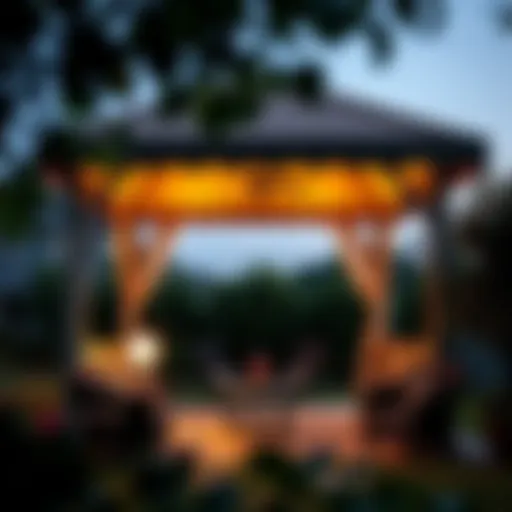Water Planters for Indoor Plants: The Complete Guide
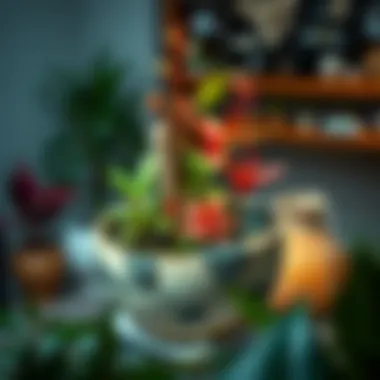
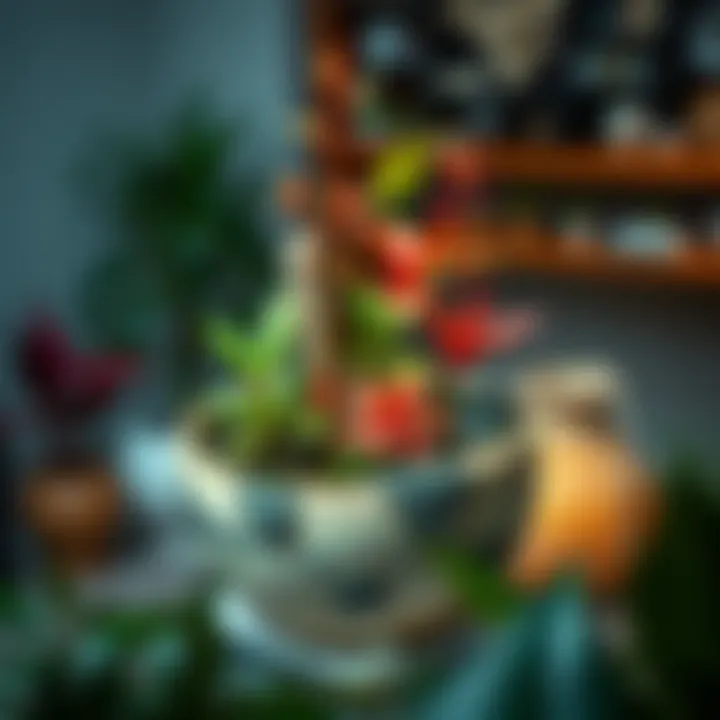
Intro
Indoor gardening has gained traction as homeowners look to bring a slice of nature into their living spaces. One particular trend that has blossomed is the use of water planters. These innovative containers offer both practical benefits and aesthetic allure, making them an attractive option for those keen on nurturing greenery without the mess associated with traditional soil planting. This article aims to dive into the world of water planters, exploring their various types, maintenance requirements, and how they can seamlessly integrate into your home decor.
The visual appeal of water planters is evident; the clarity of the container allows roots and aquatic environments to be on display. This transparency not only showcases the plant’s growth but also becomes a conversation piece in any room. Choosing the right water planter is crucial, as the design and material can greatly influence the overall atmosphere of your space. Understanding environmental impact and innovative designs will further enhance your indoor gardening experience. As we walk through this comprehensive guide, you're sure to find the insights necessary to elevate your indoor gardening game.
Prelims to Water Planters
Water planters are becoming increasingly relevant in the realm of indoor gardening. As more people seek ways to beautify their living spaces while also enhancing their wellbeing, the concept of cultivating plants using water has emerged as a practical solution. Water planters enable not just aesthetic upgrades to a home but also encourage the nurturing of plants with less hassle.
The efficiency of utilizing these planters stems from their ability to provide consistent moisture, thereby reducing worries about overwatering—an all-too-common concern amongst plant enthusiasts. When individuals incorporate water planters into their homes, they also tap into a modern approach to gardening that integrates technology and design into an engaging hobby.
Definition and Concept
At its core, a water planter is any container that facilitates the growth of plants using water as a primary medium for nurturing roots rather than soil. This method is often associated with hydroponics, a system that feeds plants through nutrient-rich water solutions.
Water planters can take various forms, such as self-watering pots or hydroponic systems, and serve a broad spectrum of houseplants, from vibrant herbs to elegant orchids. The beauty of these planters lies in their versatility, allowing individuals to experiment with different plants while enjoying the view of their roots submerged in clear water. Users gain a unique perspective into the life of the plants, fostering a closer connection to their growth.
Historical Context
The history of water planters stretches back to ancient civilizations, where early farmers and gardeners experimented with growing plants in liquid mediums. The advent of hydroponics can be traced to the Hanging Gardens of Babylon, one of the Seven Wonders of the Ancient World, which were rumored to utilize sophisticated irrigation techniques to keep plants thriving.
In more recent times, particularly during the 20th century, hydroponics has seen significant development, especially during times of food scarcity. Researchers began recognizing that growing plants in water could be a viable method for sustaining crops, especially in areas lacking fertile soil. Today, water planters have transcended their utilitarian origins and entered the realm of home decor, appealing to homeowners, designers, and gardening enthusiasts alike. The contemporary charm of water planters lies not just in their function, but in the artistry of design they bring into indoor spaces.
Benefits of Using Water Planters
Water planters come with a bouquet of advantages that caters to the diverse needs of homeowners, designers, and DIY enthusiasts alike. Understanding these benefits elevates the gardening experience while also paying heed to practicalities and aesthetics. Advancements in indoor gardening particularly highlight efficient water usage, aesthetic appeal, and a significant reduction in the risk of root rot. Together, these elements contribute to a flourishing indoor plant environment.
Efficient Water Usage
Water planters bring a game-changing approach to how we think about irrigation. Unlike traditional potted plants, these innovative setups minimize water waste significantly. When plants are cultivated in water planters, they absorb moisture as needed, leading to a more efficient growth regime. This process is often coupled with a reservoir system that controls the water supply without the need for constant attention—an ideal scenario for busy lifestyles.
To expand on this efficiency:
- Auto-regulating Water Supply: The structured design allows plants to draw water at their own pace, ensuring they do not drown or dry out.
- Reduction in Overhead: This setup can cut down on the frequency of watering sessions, saving both time and resources.
By being conscious of water utilization, you not only improve the relationship between plants and their environments, you also contribute to broader sustainability efforts. Individuals seeking to lower their water consumption at home can especially benefit, as water planters require less frequent refilling compared to conventional pots.
Aesthetic Appeal
When we talk about aesthetic appeal, water planters can effortlessly become the showstopper in any space. The visibility of roots in a well-designed planter adds a unique visual charm, setting the stage for a refreshing indoor ambiance. With the myriad of designs and colors available, one can easily find a water planter that matches or complements existing decor.
Key points to consider:
- Showcasing Roots: Transparent or semi-transparent materials showcase the intricate root systems, turning plants almost into living sculptures.
- Versatile Designs: From sleek modern styles to rustic finishes, options abound, allowing for hearty creativity in interior design.
Incorporating water planters into homes opens doors to elevate space aesthetics, letting one integrate nature into their living environments seamlessly. The vibrant greens of plants paired with intriguing designs breathe life into dull corners or shelves.
Reduced Risk of Root Rot
Root rot is a common issue for many indoor gardeners, often arising from overwatering in traditional setups. Water planters, however, mitigate this risk substantially. Their design encourages proper drainage while maintaining moisture levels that meet the plant’s needs.
Consider these aspects:
- Airy Roots: In a properly managed water planter, roots remain airy, reducing the likelihood of fungal growth and decay.
- Regulated Moisture: Maintaining an optimal moisture level diminishes the chances of waterlogged soil, which is a primary cause of root rot.
Fundamentally, this reduction in risk can lead to healthier plants and, as a result, a more successful indoor gardening journey. Enthusiasts can cultivate various species without the constant worry of losing them to a common pitfall.
"By extending the life and health of plants, water planters not only enhance individual experiences but also contribute positively to indoor ecosystems."
Types of Water Planters
Understanding the various types of water planters is essential for anyone looking to enhance their indoor gardening experience. Not only do they offer different aesthetics and functionalities, but they also serve specific plant types and care needs. Given the significance of this topic, this section will delve into three main categories: self-watering pots, hydroponic systems, and aquaponic planters. Each type provides unique advantages and challenges, making it crucial for homeowners, designers, retailers, and enthusiasts to choose wisely based on their individual goals and the plants they wish to cultivate.
Self-Watering Pots
Self-watering pots are a remarkable innovation in gardening, designed to simplify the watering process for plants. These pots typically have a reservoir at the bottom that allows plants to absorb water through a wick or a similar mechanism. This system ensures that the soil remains consistently moist, reducing the risk of overwatering or underwatering—which can be the nemesis of many indoor gardeners.
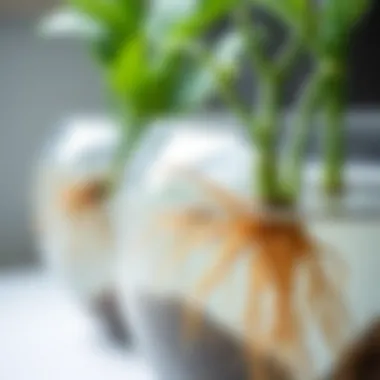
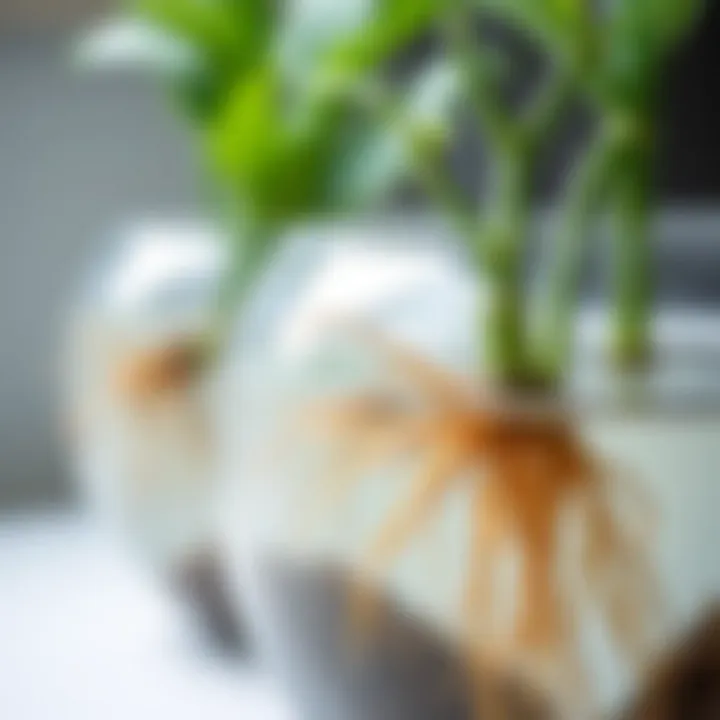
When selecting self-watering pots, it’s crucial to consider the size and type of plants you wish to grow. Most succulents, herbs, and leafy greens thrive in this environment, benefitting from the steady supply of moisture. The pots come in various styles, from ceramic to plastic, catering to aesthetic preferences and budgets alike.
Furthermore, self-watering pots can save time and effort in routine maintenance, making them perfect for busy lifestyles. However, it's important to monitor the water levels periodically and be cautious about algae growth in the reservoir.
Hydroponic Systems
Hydroponic systems represent a leap toward sustainable and innovative gardening, employing a soil-less growing method. Instead, plants grow in nutrient-rich water solutions, promoting faster growth compared to traditional soil gardening. This method’s appeal lies in its efficiency and potential to produce higher yields in less space—ideal for urban settings where square footage may be limited.
Different hydroponic setups exist, such as nutrient film techniques and deep water culture options, each suiting various types of plants. Leafy greens and herbs are often favorites in hydroponic systems due to their fast growth cycles. However, certain fruits and flowers can also flourish if the conditions are right.
Incorporating hydroponic systems into home decor can be a bold choice. With sleek designs and often vertical arrangements, they serve not just as practical gardens but also as chic living art pieces that captivate admirers. Nevertheless, attention to detail in monitoring nutrient levels and pH balance is critical to guarantee plant health.
Aquaponic Planters
Aquaponics stands as a harmonious blend of aquaculture and hydroponics, creating an ecosystem where fish and plants thrive together. In essence, fish waste provides organic nutrients for the plants, while the plants filter the water, returning it cleaner to the fish tank. This closed-loop system exemplifies an incredible understanding of resource management and mutual benefit, making it exceptionally sustainable.
Ideal for those who are committed to an alternative gardening approach, aquaponic planters can support a variety of plants, from culinary herbs to fruiting plants, alongside fish, which can be an entertaining component of the system.
However, managing an aquaponic system requires knowledge and commitment. It necessitates regular monitoring of water quality, fish health, and plant needs. While they may require more initial setup and care than traditional planters, the rewards can lead to a fruitful harvest and an engaging experience in your indoor space.
"It's all about finding the right balance—when plants and fish collaborate, everyone thrives!"
Epilogue
In this walkthrough of water planters, it’s clear there’s no one-size-fits-all solution. Each type—self-watering pots, hydroponic systems, and aquaponic planters—holds its own merits and demands. Choosing the right approach is foundational to achieving both aesthetic brilliance and successful plant growth within your home.
Choosing the Right Plants for Water Planters
Selecting the appropriate plants for water planters is of utmost importance, particularly because certain species can flourish in a water-based environment while others could simply wither away. When considering plants for indoor water planters, one must focus on those that are naturally adapted to wet conditions. The benefits of this selection process are plentiful; successful plant growth can lead to stunning indoor displays and contribute to a healthier living space.
By choosing the right plants, homeowners can avoid the heartache of failed attempts at gardening. Moreover, thriving plants can enhance air quality, bring a sense of life to the atmosphere, and elevate the aesthetic appeal of your home—all significant motivators for anyone keen on indoor gardening.
Plants Thriving in Water Settings
Some plants have a natural affinity for aquatic environments, making them prime candidates for water planters. Here’s a brief list of plants that generally do well when grown in a water-based setup:
- Pothos (Epipremnum aureum): Known for its resilient nature, Pothos adapts well to water. With its cascading vines, it adds an attractive element to any room.
- Bamboo: This hardy plant not only thrives in water but also comes with a cultural emphasis of good fortune, which many people appreciate.
- Peace Lily (Spathiphyllum): Well-regarded for its stunning white blooms, the Peace Lily can also be grown in water effortlessly. Just ensure it gets the right amount of indirect light.
- Spider Plant (Chlorophytum comosum): This is a great starter plant for those new to water planters, as it grows readily in water and is low-maintenance.
Choosing these types can help ensure your water planter setup is both visually appealing and functional.
Considerations for Plant Selection
When selecting plants for your water planters, there are several considerations that should not be overlooked:
- Water Quality: It’s crucial to choose plants that can adapt to the specific quality of water you have on hand. Some require nutrient-rich water, while others do better in distilled or filtered water.
- Light Conditions: Each plant has its light requirements. Most indoor plants do best in indirect sunlight. Knowing the specific needs of your chosen plants can save you time and resources in the long run.
- Space and Size: Consider the mature size of the plants. Some may start out small but grow large quickly, needing more space than anticipated.
- Compatibility: If you are thinking of combining several types in one planter, ensure they are compatible with each other's nutrient needs and growth habits; otherwise, one type may overshadow the other.
Choosing the right plants is akin to setting the stage for a play. If the actors are well-suited for their roles, the outcome is bound to be successful.
Taking these factors into account will greatly enhance your chances of creating a thriving indoor garden that can resist pests and adapt to changes, celebrating the union of nature and home decor.
Designing with Water Planters
Designing with water planters is not just about putting plants in a pot; it's an art form that blends functionality with aesthetics. Water planters can transform spaces in your home, making them more inviting while also fulfilling the practical need for plant care. When considering the integration of water planters into your interior design, it’s essential to think about how they complement your space, enhance your decor, and serve as conversation starters.
Integrating with Home Decor
To integrate water planters into home decor, it’s crucial to first assess the overall style of the space. Is it modern, rustic, minimalist, or bohemian? Each style calls for different approaches:
- Modern Spaces: In a sleek environment, opt for clear glass water planters that showcase the roots through transparent surfaces. This design can create an illusion of additional space while highlighting the beauty of the plant.
- Rustic Environments: Wooden water planters offer an earthy touch. They provide warmth and blend seamlessly with natural elements like stones and fabrics. Consider using reclaimed wood for an eco-friendly approach.
- Minimalist Designs: A single dramatic water planter with a big leafy plant can serve as a focal point. Less is more, and achieving that involves careful selection of both plant and planter.
- Bohemian Styles: Here, the more eclectic, the better. Mix and match various shapes, sizes, and colors of water planters to create a vibrant look.
When incorporating water planters into your home, take into account the lighting conditions. Some plants flourish under bright direct sunlight, while others prefer the shade. Ensuring the placement aligns with the plant's light requirements will yield better growth and maintain a healthy indoor garden.
Color and Material Choices
Selecting the right color and material for your water planters is as vital as the choice of plants themselves. Not only do these factors affect the visual appeal, but they also influence the maintenance and durability of the planters.
- Color: The color palette should resonate with the colors already present in your home.
- Material: The material of your water planters impacts both aesthetics and function:
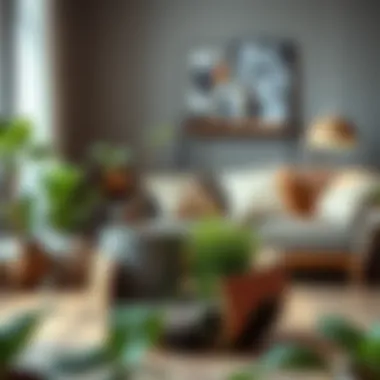
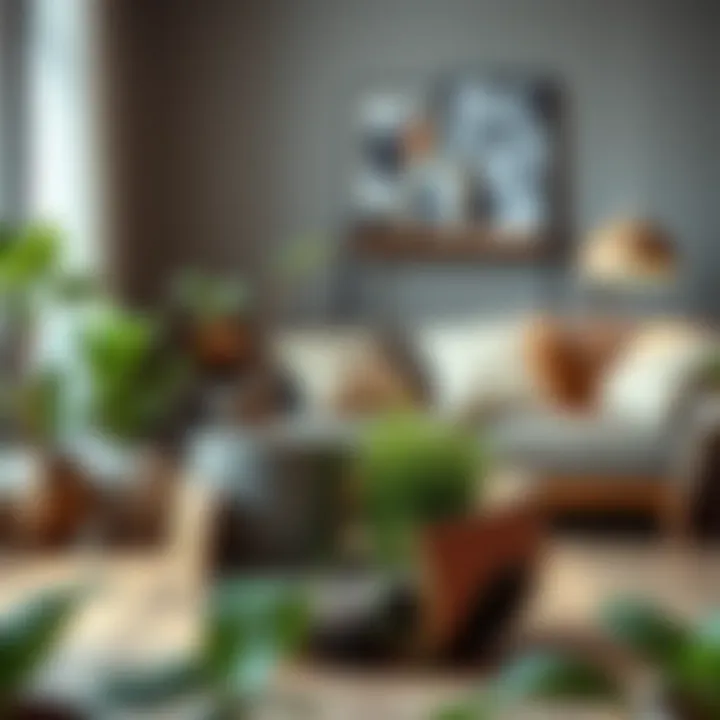
- For a calm and serene ambiance, consider choosing soft hues like pastel blues or greens.
- For a bold statement, vivid colors such as deep reds or oranges can energize the space.
- Neutral colors like white or black are always classic options that create a clean, modern look.
- Glass: Provides an elegant look, perfect for showcasing roots and water levels. However, it can be heavy and needs careful handling.
- Ceramic: Often hand-painted, ceramics add character and can offer a variety of textures. These are generally sturdy but may not be as transparent.
- Plastic: Available in a wide range of colors and styles, plastic is lightweight and offers versatility but may lack the elegance of more traditional materials.
When choosing both color and material, it’s essential to think about the water and plant health. For instance, dark materials can absorb heat which might affect the water temperature, impacting plant health.
Integrating water planters into your home isn't just about decor; it’s about crafting your own little green paradise tailored to your taste and lifestyle. Remember, "the best way to keep a secret is to make it look effortless." Figuring out how to create a seamless blend of design, care, and beauty is just the beginning of your journey with water planters.
For further reading on how plants and indoor gardening enhance living spaces, check these links: Wikipedia on Indoor Gardening and Britannica on Houseplants.
Care and Maintenance of Water Planters
Taking care of water planters effectively is crucial for ensuring the health and longevity of indoor plants. Unlike traditional soil planters, water planters require a different approach to maintenance, focusing on water quality, fertilization, and hygiene. Understanding these factors is vital to keeping your plants vibrant and thriving in their aquatic environment.
Monitoring Water Quality
The cornerstone of any successful water planter setup is clean and well-balanced water. Plants absorb nutrients directly from water, so the quality directly affects their growth. Keeping an eye on the pH levels is essential. Most houseplants do well in slightly acidic conditions, generally between 6.0 and 7.0.
Remember, poor water quality can lead to sick plants.
Here are some tips for monitoring water quality:
- Test the Water: Use pH testing kits, readily available at gardening stores, to keep tabs on water conditions.
- Change Water Regularly: To prevent stagnation and the growth of harmful bacteria, change the water every couple of weeks.
- Check for Clarity: Water should be clear. If it's cloudy or murky, it’s time for a change.
- Use Filtered Water: If possible, utilize filtered or distilled water. Tap water may contain chemicals like chlorine, which can affect plant health.
Maintaining optimal water quality not only helps prevent root rot but ensures your plants get all the nutrients they need.
Fertilization Techniques
While water planters reduce certain nutrient deficiencies seen in traditional soil planters, they still require fertilizers to ensure adequate growth. The key is to use the right kind of fertilizer.
Liquid fertilizers are a popular choice for water planters, as they dissolve easily. Look for ones that are specifically formulated for hydroponics, as they often include essential nutrients tailored for plants grown in water.
Here’s how to integrate fertilization into your routine:
- Dilution is Key: Follow manufacturer recommendations—over-fertilizing can lead to nutrient burn. Generally, a quarter to half strength of what a soil plant would require works well.
- Frequency Matters: Fertilizing every 4-6 weeks is typically sufficient, but always monitor your plants’ responses.
- Observe Plant Reaction: Yellowing leaves or sudden growth spurts can indicate the need for a boost or a reduction in fertilization.
Finding the right balance in fertilization encourages a robust growth cycle without overwhelming the plants.
Cleaning and Hygiene Practices
Just as one would clean traditional pots and surfaces, hygiene is non-negotiable for water planters. Algae and bacteria can proliferate quickly in stagnant water; thus, regular cleaning is essential.
Consider these practices for maintaining cleanliness:
- Wash Containers Thoroughly: Every time you change the water, take the opportunity to rinse out the container with mild soap or vinegar to remove algae and bacteria. Rinse thoroughly to remove all soap residues.
- Inspect Plant Roots: When changing water, always check the conditions of the roots. They should be white and plump, not brown or mushy.
- Avoid Overcrowding: Too many plants in one container can lead to hygiene issues and stunted growth. Give each plant enough room to breathe.
- Control Light Exposure: Sometimes, algae bloom can stem from too much light. Place your planters in well-lit spots but not in direct sunlight for prolonged periods.
By implementing these cleaning practices, you can create a sterile environment conducive to healthy aquatic growth. Regular maintenance helps avoid common pitfalls and ensures that your plants continue to flourish.
In summary, the care and maintenance of water planters is a mixture of proper water quality, nutrient management, and consistent cleaning. By paying attention to each aspect, you can cultivate a thriving indoor garden that showcases the beauty of your plant collection.
Environmental Impact of Water Planters
The use of water planters isn't just a trend in home decor; it's a significant step towards creating a more sustainable urban environment. Understanding the environmental impact of these planters invites us to look at how they can play a crucial role in our ongoing battle against climate change. By embracing efficient water usage and reducing our footprint, homeowners, designers, and gardening enthusiasts alike can contribute positively to the planet.
Sustainability in Indoor Gardening
Water planters represent a remarkable avenue in sustainable gardening practices. One key aspect is their ability to conserve water. These systems are built to ensure optimal hydration of plants while minimizing waste, a stark contrast to traditional soil gardening which can often lead to over or under-watering. When you think about it, the often-touted phrase "water is life" holds true, especially in our current climate, where droughts become increasingly common.
Moreover, water planters often employ smart irrigation practices, which can further enhance their sustainability. These mechanisms help monitor moisture levels, ensuring that plants get only what they need for healthy growth. As a result, using water planters not only supports thriving greenery but also empowers homeowners to manage their water resources more effectively.
"In a world where every drop counts, innovative gardening solutions like water planters can make a tangible difference."
Reduction of Plastic Use
Another remarkable benefit of water planters is their role in reducing plastic use. Many conventional plant pots are made from single-use plastics that contribute heavily to pollution and landfill overflow. With water planters, especially those manufactured from sustainable materials, there's an opportunity to markedly lessen our reliance on plastics.
Choosing planters made from biodegradable materials or those that are recyclable can shift the paradigm of indoor gardening. Transitioning to such options not only keeps our homes beautiful but ensures that our choices contribute to a cleaner environment. Moreover, some innovative designs focus on using recycled materials, further aligning with the goals of reducing waste and promoting a circular economy.


In summary, as homeowners and designers consider the impact of their choices, water planters show a promising avenue not only for nurturing indoor plants but also for promoting sustainable living. The intersection of environmental consciousness and style serves as an invitation to dive deeper under the surface of gardening practices and consider how small changes can yield significant benefits.
Challenges of Water Planters
Water planters certainly bring a fresh approach to indoor gardening, but they aren’t without challenges. Understanding these pitfalls can make all the difference between a thriving indoor garden and a struggling one. Homeowners, designers, and gardening enthusiasts alike need to be aware of specific issues that can crop up.
Algal Growth Issues
One of the foremost challenges with using water planters is the risk of algal growth. In many cases, water planters offer a moist environment that can be a breeding ground for algae. When the water is not properly maintained or if it’s exposed to too much light, algae can flourish, turning your serene green space into an unsightly mess. This isn't just a cosmetic concern; if left unchecked, algal blooms can deplete oxygen levels in the water, negatively impacting your plants.
Here are some practical tips to combat algal growth:
- Limit Light Exposure: Position your planters where they won’t receive direct sunlight. Algae thrive on light, so a little shade can go a long way.
- Regularly Change Water: If you stick to a schedule of replacing water every few weeks, you can disrupt algae's growth cycle.
- Use Natural Treatments: Introducing small aquatic animals like certain snails can help keep algae at bay naturally. These little critters munch on algae, providing a greener solution than chemicals.
"Keeping algae at bay is like managing a little monster in your home—it requires vigilance, but it’s doable."
Pest Management
Pests can be another thorn in the side for water planter enthusiasts. While you might think that the aquatic environment limits pest activity, the truth is that pests like fungus gnats can still find their way. These pesky insects thrive in moist conditions, making water planters especially inviting. Their larvae feed on plant roots, which can hinder growth or even kill the plant altogether.
To effectively manage pests in water planters, consider these strategies:
- Check for Signs: Regularly inspect for pests during your water changes. Look under leaves and check for tiny flies hovering around the planters.
- Use Sand Layers: A thin layer of sand on top of the water or soil can deter gnats from laying eggs, as they prefer to bury their eggs in damp soil.
- Diatomaceous Earth: Sprinkle diatomaceous earth around your plants. It’s a non-toxic option that works by dehydrating any pests that come in contact with it.
Navigating the challenges of water planters requires an understanding of both the potential pitfalls and effective strategies to counteract them. By staying informed and proactive, you can enjoy the myriad benefits that water planters bring, without falling prey to the common obstacles.
Innovative Trends in Water Planters
As the gardening landscape continues to evolve, water planters are not just keeping up; they are paving the way for smarter, more sustainable indoor gardening practices. This section explores how innovative trends are changing the way homeowners and enthusiasts perceive and use water planters. These advancements come with specific elements that make them appealing and beneficial, especially for those keen on enhancing their indoor environments.
Smart Water Planters
Smart water planters are truly a game changer in indoor gardening. Equipped with sensors, these planters can monitor moisture levels, nutrient content, and even light exposure. This high-tech approach allows for precise care, making it easier for plants to thrive, especially for those who might not have a green thumb. The technology can sync with smartphones or tablets, providing reminders for watering and feeding.
Some benefits include:
- Efficiency: Smart planters deliver just the right amount of water, minimizing waste.
- Convenience: With notifications sent directly to a user’s phone, care becomes easier, allowing for a more hands-off approach.
- Data-Driven Insights: Users can track the health of their plants and adjust care based on actionable data.
These planters also often come with integrated lighting solutions, further enhancing both growth and aesthetics. Imagine a sleek planter that not only waters your plant but also provides that extra boost of light when needed. It's a niche that connects technology and nature in the most practical way.
Customizable Modular Systems
Then there are customizable modular systems which cater to those with a creative flair. These systems allow users to design their own indoor gardens by linking various water planters in different configurations. It’s akin to playing with building blocks but with a purpose.
Here’s why these systems are gaining traction:
- Flexible Arrangements: Homeowners can adapt their setup according to their space and aesthetic preferences. Want to create a vertical garden on your wall? You can.
- Scalability: Whether you're starting small or dreaming big, modular systems grow with you. You can add more modules over time as your indoor plant passion expands.
- Unique Designs: These systems often come in various materials and colors, fitting in with any décor while serving a function.
The rise of both smart water planters and customizable systems reflects a broader movement towards sustainability and individual expression in home gardening. Homeowners are reminded that taking care of plants can be as innovative as it is soothing. As trends evolve, many are set to adopt these solutions, paving a vibrant future for indoor gardening.
"Investing in innovative water planters can transform your indoor space into a lush backdrop that not only exudes beauty but also promotes a healthier home environment."
Check out more resources on smart gardening at Wikipedia and Britannica.
Innovative trends in water planters mark a pivotal shift in how we engage with plant life indoors. They not only play a crucial role in maximizing plant health and enhancing home design but also signify a movement towards a more sustainable and enjoyable approach to gardening.
Finale
As we draw this exploration of water planters to a close, it's vital to reflect on the myriad aspects discussed throughout this guide. Water planters for indoor plants serve not just as functional gardening tools, but also as aesthetic enhancements that contribute to the overall ambiance of living spaces. In today’s fast-paced, urban environments, where green space is often limited, these innovative systems provide a sustainable approach to indoor gardening.
Summary of Key Points
The main highlights from this article include:
- Benefits of Water Planters: Efficient water usage, enhanced visual appeal, and reduced risks linked to root rot. These benefits emphasize the practical advantages they offer, particularly for busy homeowners and plant enthusiasts alike.
- Types of Water Planters: The variety available—ranging from self-watering pots to advanced hydroponic and aquaponic systems—allows for flexibility and adaptability in various home settings. This caters to different gardening preferences and expertise levels.
- Plant Selection: Emphasizing the importance of choosing plants that thrive in water-based environments is crucial. This consideration not only leads to healthier plants but also reduces maintenance challenges.
- Design Integration: The way water planters can blend with home decor speaks to their dual role as both functional and aesthetic elements in any room.
- Environmental Impact: Shifting towards water planters can significantly mitigate plastic use and promote sustainability within indoor gardening.
- Challenges and Innovations: Understanding potential issues like algal growth and pest management is important for maintaining a healthy indoor garden, while new trends like smart planters showcase the ongoing evolution within this gardening niche.
Final Thoughts on Water Planters
"Integrating green elements into our daily lives is not merely a trend, but a vital journey towards nurturing a sustainable ecosystem."
For additional reading on indoor gardening and water planters, consider exploring resources like Wikipedia or visiting plant enthusiast forums on Reddit.
This guide aims to equip you with a comprehensive overview, inspiring you to start or enhance your journey in indoor gardening through the use of water planters.













